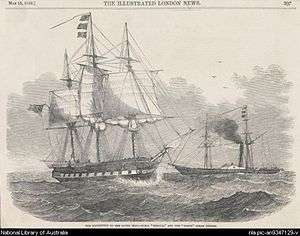HMS Herald (1822)
 HMS Herald and steamship tender Torch, Expedition to the South Sea, Illustrated London News, 15 May 1852. | |
| History | |
|---|---|
| Name: | HMS Herald |
| Ordered: | 5 June 1819 |
| Builder: | East India Company dockyard, Cochin, British India |
| Laid down: | March 1820 |
| Launched: | 15 November 1822 |
| Commissioned: | 16 July 1824[1] |
| Renamed: |
|
| Reclassified: |
|
| Fate: | Sold for breaking on 28 April 1862 |
| General characteristics [1] | |
| Class and type: | Atholl-class 28-gun sixth-rate corvette |
| Tons burthen: | 499 91⁄94 (bm) |
| Length: |
|
| Beam: | As built:31 ft 10 in (9.7 m) *For tonnage:31 ft 6 in (9.6 m) |
| Depth of hold: | 8 ft 9 in (2.67 m) |
| Sail plan: | Full-rigged ship |
| Complement: | 175 |
| Armament: |
|
HMS Herald was an Atholl-class 28-gun sixth-rate corvette of the Royal Navy. She was launched in 1821 as HMS Termagant, commissioned in 1824 as Herald and converted to a survey ship in 1845. After serving as a chapel ship from 1861, she was sold for breaking in 1862.
Early career
Termagant was launched at the East India Company dockyard at Cochin, British India on 15 November 1821. Lieutenant Robert Wallace Dunlop commissioned on 30 July 1822 to sail her to the United Kingdom. She arrived at Portsmouth on 7 July 1823. In July Captain Lord Henry Frederick Thynne took command, though he had nominally been appointed about a year earlier, on 30 July 1822.[1]
She was renamed Herald on 15 May 1824, and commissioned on 16 July 1824. At this time she was rated a yacht.[1]
Commander Henry John Leeke recommissioned her on 31 May 1824. He sailed her to St Petersburg, the West Indies, back to England from Havana, then to Quebec, and finally to Malta.[1]
Captain Sir Augustus William James Clifford recommissioned Herald on 27 May 1826 to carry the Duke of Devonshire on an embassy to Russia. CommanderHenry Eden replaced Clifford in November 1826, only to hand over command to Commander Edward William Curry Astley in April 1827.[1]
On 7 April 1829 Commander George Berkeley Maxwell replaced Astley. Maxwell sailed Herald to St Petersburg, Cartagena, Quebec, and home.
Herald was paid off in 1830. She then underwent fitting for sea between April and July 1830.[1]
On 20 November 1830 Captain Robert Godon took command at Portsmouth. He paid her off in January 1831. She then underwent fitting for sea again between November 1837 and August 1838.[1]
Service in New Zealand
Captain John Nias recommissioned Herald on 24 May 1838 for the East Indies and China.[1]
On 29 April 1840 Nias sailed Herald, with Major Thomas Bunbury of the 80th Regiment (appointed by Governor William Hobson as Commissioner) and Edward Marsh Williams as interpreter, to take a copy of the Treaty of Waitangi (known as the ‘Herald-Bunbury’ copy) to the South Island of New Zealand to obtain signatures from Māori chiefs as part the process of claiming British sovereignty over New Zealand.[2][3]
Service in the First Anglo-Chinese War
During the period 1841–42 she was involved in actions off Canton in the fleet commanded by Sir William Parker in the First Anglo-Chinese War (1839–42),[4] known popularly as the First Opium War. Herald was paid off at Chatham in 1842.
Survey voyages
Herald was converted at Sheerness to a survey ship between July 1844 and June 1845. At that time her armament was reduced to eight guns.[1]
In 1845 Henry Kellett recommissioned Herald 8 February 1845 for surveying in the Pacific.[1] Together with HMS Pandora she conducted a survey of the coast of British Columbia after the Oregon boundary dispute with the United States.[5]
Herald was assigned in 1848 to join the search for Sir John Franklin who had been exploring the Northwest Passage. During this voyage Herald sailed through the Bering Strait across the Chukchi Sea and discovered Herald Island, which Kellett named after his ship. She was then paid of in 1848.
From 1852 to 1861, under the command of Captain Henry Mangles Denham, Herald carried out a survey of the Australian coast and Fiji Islands, continuing the mission of HMS Rattlesnake. The naturalists on the voyage were John MacGillivray (1821–1867), William Milne (botanist) and Denis Macdonald as Assistant Surgeon-zoologist. However following disagreements with the captain, John MacGillivray disembarked at Sydney in January 1854.
She was the first sailing ship to enter the Fitzroy Dock, Cockatoo Island in Sydney Harbour.[6]
Herald was recommissioned on 1 April 1857 in the surveying role, and was paid off in 1849.[1]
Fate
Herald was converted to a chapel ship and was used as a floating church in Shoreham in September 1861.[1] She was sold to Castle for breaking on 28 April 1862.[1]
See also
Notes
- 1 2 3 4 5 6 7 8 9 10 11 12 13 14 Winfield (2004) p.113.
- ↑ "Williams, Edward Marsh 1818–1909". Early New Zealand Books (NZETC). 1952. Retrieved 18 October 2013.
- ↑ "Treaty of Waitangi signing locations: 'Herald-Bunbury' copy". NZ History Online. Retrieved 18 October 2013.
- ↑ "HMS HERALD (Anglo-Chinese war 1842)". Retrieved 23 December 2012.
- ↑ "Herald at the William Loney website". Retrieved 2011-05-22.
- ↑ Gillett, p.12.
References
- Gillett, Ross; Melliar-Phelps, Michael (1980). A Century of Ships in Sydney Harbour. Rigby Publishers Ltd. ISBN 0-7270-1201-0.
- Edward Forbes (1815–1854), The zoology of the voyage of H.M.S. Herald under the command of Captain Henry Kellett,... during the years 1845-51. (London, 1854).
- Winfield, Rif & Lyon, David (2004). The Sail and Steam Navy List: All the Ships of the Royal Navy 1815–1889. London: Chatham Publishing. ISBN 978-1-86176-032-6. OCLC 52620555.